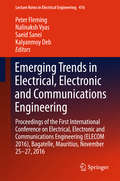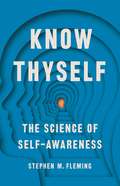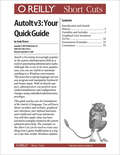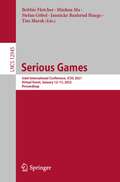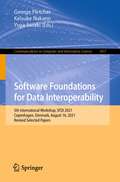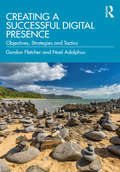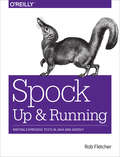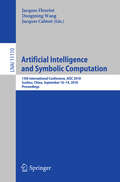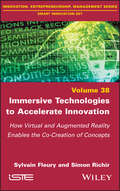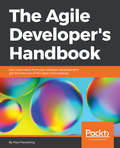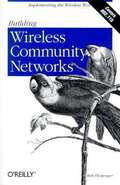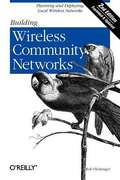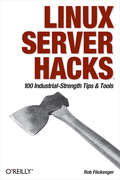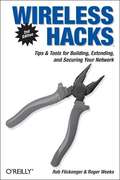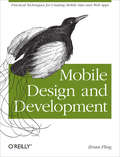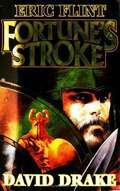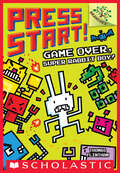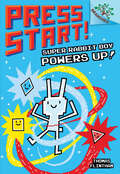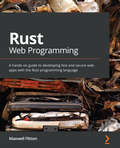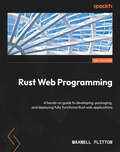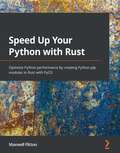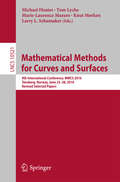- Table View
- List View
Emerging Trends in Electrical, Electronic and Communications Engineering
by Peter Fleming Nalinaksh Vyas Saeid Sanei Kalyanmoy DebThe book reports on advanced theories and methods in two related engineering fields: electrical and electronic engineering, and communications engineering and computing. It highlights areas of global and growing importance, such as renewable energy, power systems, mobile communications, security and the Internet of Things (IoT). The contributions cover a number of current research issues, including smart grids, photovoltaic systems, wireless power transfer, signal processing, 4G and 5G technologies, IoT applications, mobile cloud computing and many more. Based on the proceedings of the first International Conference on Emerging Trends in Electrical, Electronic and Communications Engineering (ELECOM 2016), held in Voila Bagatelle, Mauritius from November 25 to 27, 2016, the book provides graduate students, researchers and professionals with a snapshot of the state-of-the-art and a source of new ideas for future research and collaborations.
Know Thyself: The Science of Self-Awareness
by Stephen M FlemingUnlock the secrets to understanding yourself and others with the surprising science of the human mind's greatest power: introspection. &“Are you sure?&” Whether in a court room, a doctor&’s office, a gameshow&’s hot seat, or a student&’s desk, we are always trying to answer that question. Should we accept eyewitness testimony or a physician&’s diagnosis? Do we really want to risk it all on a final question? And what should we be studying in order to do as well as possible on a test? In short, how do we know what we and others know—or as importantly, don&’t know? As cognitive neuroscientist Stephen Fleming shows in Know Thyself, we do this with metacognition. Metacognition, or thinking about thinking, is the most important tool we have for understanding our own mind. Metacognition is an awesome power: It is what enables self-awareness as well as what lets us think about the minds of others. It is the ultimate human trait, and in its most rarefied forms is a power that neither other animals, nor our current artificial intelligences, have. Metacognition teaches us the limits of our own knowledge. Once we understand what it is and how it works, we can improve our performance and make better decisions. For example, on the SAT, it helps us gauge when we should skip a question rather than lose points getting an answer wrong. Know Thyself, like the metacognition itself, is equal parts scientific, philosophical, and practical. And that means, like Thinking, Fast and Slow and Predictably Irrational, it&’s that rarest of books: one that can both expand our minds and change our lives.
AutoIt v3: Your Quick Guide
by Andy FlesnerAutoIt is becoming increasingly popularin the system administration field as atool for automating administrative tasks.Although this is one of its more popularuses, you can use AutoIt to automateanything in a Windows environment.This powerful scripting language can runany program and manipulate keyboardand mouse input. With its RunAs support,administrators can perform unattendedinstallations and configurationchanges using embedded administrativeprivileges.This guide teaches you the foundationsof the AutoIt v3 language. You will learnabout variables and includes, graphicaluser interfaces, user-defined functions,and conditional and loop statements.You will then apply what you havelearned in examples related to the systemadministration field. The examples inthis Short Cut can be used to create anythingfrom a game modification to a logonscript that verifies Windows updates.
Serious Games: Joint International Conference, JCSG 2021, Virtual Event, January 12–13, 2022, Proceedings (Lecture Notes in Computer Science #12945)
by Bobbie Fletcher Minhua Ma Stefan Göbel Jannicke Baalsrud Hauge Tim MarshThis book constitutes the refereed proceedings of the 7th Joint International Conference on Serious Games, JCSG 2021, as virtual event, in January 2022.The 17 full papers presented together with 3 short papers were carefully reviewed and selected from 28 submissions. JSCG 2021 is dedicated to serious games and its interdisciplinary characteristics combining game concepts and technologies required in the different application domains.
Software Foundations for Data Interoperability: 5th International Workshop, SFDI 2021, Copenhagen, Denmark, August 16, 2021, Revised Selected Papers (Communications in Computer and Information Science #1457)
by George Fletcher Keisuke Nakano Yuya SasakiThis book constitutes selected papers presented at the 5th International Workshop on Software Foundations for Data Interoperability, SFDI 2021, held in Copenhagen, Denmark, in August 2021. The 4 full papers and one short paper were thorougly reviewed and selected from 8 submissions. They present discussions in research and development in software foundations for data interoperability as well as the applications in real-world systems such as data markets.
Happy Mum, Happy Baby: My adventures into motherhood
by Giovanna FletcherCONTAINS A BRAND NEW CHAPTERSunday Times Number One Bestseller Happy Mum Happy Baby is now a Number One podcast. A positive and uplifting book about what it is to be a mother and all things mum and baby by Celebrity Mum of the Year and phenomenally popular vlogger, author, TV presenter and actress Giovanna Fletcher.Being a mum is an incredible journey, a remarkable experience that changes how we look, how we feel, who we are. As mothers we are strong, protective, proud. We feel a love like no other.But being a parent can be hard too. It challenges us physically, mentally, emotionally. There are the days where just managing to fit a shower in amidst the endless feeding, entertaining young children and surviving on a lack of sleep feels like an achievement. With so many people ready to offer 'advice' on the best way to parent, it can feel like you are getting it all wrong.Since Giovanna and her husband Tom Fletcher have had their sons Buzz and Buddy, they have been sharing glimpses of their family life. With an infectiously positive outlook and happy take on all things mum-related, Giovanna has developed a following of fellow parents and mums-to-be.This is not a book about how to have the perfect family experience - Gi would be the first to admit she is winging it just as much as the rest of us - instead it is an honest, upbeat and incredibly personal account of her own experience of having a family. In Happy Mum, Happy Baby Giovanna shares her own journey through parenthood and in doing so, she looks at what it is to be a mother today, encourages you to be confident in yourself as a parent and celebrates how putting a focus on being a happy and confident mum can really make for a happy baby.
Happy Mum, Happy Baby: My adventures into motherhood
by Giovanna FletcherBeing a mum is an incredible journey, a remarkable experience that changes how we look, how we feel, who we are. As mothers we are strong, protective, proud. We feel a love like no other.But being a parent can be hard too. It challenges us physically, mentally, emotionally. There are the days where just managing to fit a shower in amidst the endless feeding, entertaining young children and surviving on a lack of sleep feels like an achievement. With so many people ready to offer 'advice' on the best way to parent, it can feel like you are getting it all wrong.Since Giovanna and her husband Tom Fletcher have had their sons Buzz and Buddy, they have been sharing glimpses of their family life. With an infectiously positive outlook and happy take on all things mum-related, Giovanna has developed a following of fellow parents and mums-to-be.This is not a book about how to have the perfect family experience - Gi would be the first to admit she is winging it just as much as the rest of us - instead it is an honest, upbeat and incredibly personal account of her own experience of having a family. In Happy Mum, Happy Baby Giovanna shares her own journey through parenthood and in doing so, she looks at what it is to be a mother today, encourages you to be confident in yourself as a parent and celebrates how putting a focus on being a happy and confident mum can really make for a happy baby.(P)2017 Hodder & Stoughton
Creating a Successful Digital Presence: Objectives, Strategies and Tactics
by Gordon Fletcher Noel AdolphusIncreasingly graduates, and anyone who is entering employment, need an individual digital presence to stand out and showcase themselves to secure their first professional role. This book takes an employability approach to encourage those currently studying, or about to enter the world of work, to develop a set of skills that enables them to recognise and deliver an effective digital presence, firstly for themselves and then for the organisations who would employ them. It does not assume any prior technical knowledge and emphasises the value and benefits of creating a presence to actively participate in the digital economy. By structuring the chapters incrementally, the reader is guided through the development of their own presence while also being given the concepts and tools that will enable them in the future to scale this activity to suit the needs of a startup, an SME or a social business. By using well-established business principles to design a strategy, the reader is guided through the creation of a personal Theory of Change that will enable them to turn an abstract goal into an individual digital presence through a defined series of stages and intermediate change objectives. The book then proposes a series of tactics to draw out concrete actions. A range of examples and case studies from around the world feature in each chapter to showcase the range of different types of digital presence that can be created. By using a strategic and systematic process, this book draws together academic thinking with tangible and highly practical outcomes. It is essential reading for advanced undergraduate and postgraduate students studying any discipline related to the digital world, particularly digital marketing and digital business, entrepreneurship and strategy, as well as those taking employability and personal professional development programmes.
Spock: Writing Expressive Tests in Java and Groovy
by Rob FletcherMost developers would agree that writing automated tests is a good idea, but writing good, well-structured tests is still an elusive skill for many. For Java and Groovy developers, however, there’s good news. This practical guide shows you how to write concise and highly readable tests with Spock, the most innovative testing and specification framework for the JVM since JUnit.Author Rob Fletcher takes you from Spock basics to advanced topics, using fully worked integration examples. Through the course of this book, you’ll build a simple web application—Squawker—that allows users to post short messages. You’ll discover how much easier it is to write automated tests with Spock’s straightforward and expressive language.Start by learning how to write simple unit testsUnderstand the lifecycle of Spock specifications and feature methodsDive into interaction testing, using Spock’s intuitive syntax for dealing with mocks and stubsLearn about parameterized tests—writing feature methods that run for multiple sets of dataMove into advanced topics, such as writing idiomatic Spock code and driving parameterized tests with file or database inputLearn how everything works together in a standalone, fully-worked, test-driven development example
Artificial Intelligence and Symbolic Computation: 13th International Conference, AISC 2018, Suzhou, China, September 16–19, 2018, Proceedings (Lecture Notes in Computer Science #11110)
by Jacques Fleuriot Dongming Wang Jacques CalmetThis book constitutes the refereed proceedings of the 13th International Conference on Artificial Intelligence and Symbolic Computation, AISC 2018, held in Suzhou, China, in September 2018. The 13 full papers presented together with 5 short and 2 invited papers were carefully reviewed and selected from 31 submissions. The AISC conference is an important forum when it comes to ensuring that ideas, theoretical insights, methods and results from traditional AI can be discussed and showcased, while fostering new links with other areas of AI such as probabilistic reasoning and deep learning.
Immersive Technologies to Accelerate Innovation: How Virtual and Augmented Reality Enables the Co-Creation of Concepts
by Sylvain Fleury Simon RichirThe digital transformation of companies is both a competitive challenge and a complex step for large groups and industries, and at the same time a tremendous opportunity. This transformation is entering a new dimension with the development of immersive technologies such as virtual reality, mixed reality and augmented reality, which are revolutionizing the way we generate content as well as visualize and interact with models and data.The challenges of innovation and digital transformation within companies are now converging. Research shows the potential that immersive technologies have to accelerate the first steps of the innovation process.The objective of this book is to provide a clear vision of the state of research on immersive technologies for design and to deliver practical recommendations for companies wishing to improve their innovation process.
The Agile Developer's Handbook: Get more value from your software development: get the best out of the Agile methodology
by Paul FlewellingA pragmatic companion guide to your Agile journey Key Features Make your team Agile by implementing industry-standard Agile techniques Assess scope, scale up efficiently Create the correct roles and identify the right candidates for your team Finish your projects faster and stay ahead of the curve Book Description This book will help you overcome the common challenges you’ll face when transforming your working practices from waterfall to Agile. Each chapter builds on the last, starting with easy-to-grasp ways to get going with Agile. Next you’ll see how to choose the right Agile framework for your organization. Moving on, you’ll implement systematic product delivery and measure and report progress with visualization. Then you’ll learn how to create high performing teams, develop people in Agile, manage in Agile, and perform distributed Agile and collaborative governance. At the end of the book, you’ll discover how Agile will help your company progressively deliver software to customers, increase customer satisfaction, and improve the level of efficiency in software development teams. What you will learn Create a solid foundation that gives your team an Agile jumpstart Understand how to select and evolve practices to increase your team’s agility Use experiments to accelerate your team’s understanding Fine-tune your approach by incorporating aspects of Lean and Lean Startup Know how to foster an environment of continuous improvement and learning that will become self-sustainingWho this book is for If you’re a software developer or a project manager with little to no experience of Agile, but you want to efficiently implement it, this is the book for you.
Building Wireless Community Networks
by Rob FlickengerBuilding Wireless Community Networksoffers a compelling case for building wireless networks on a local level: They are inexpensive, and they can be implemented and managed by the community using them, whether it's a school, a neighborhood, or a small business. This book also provides all the necessary information for planning a network, getting the necessary components, and understanding protocols that you need to design and implement your network.
Building Wireless Community Networks, 2nd Edition
by Rob FlickengerBuilding Wireless Community Networks is about getting people online using wireless network technology. The 802.11b standard (also known as WiFi) makes it possible to network towns, schools, neighborhoods, small business, and almost any kind of organization. All that's required is a willingness to cooperate and share resources. The first edition of this book helped thousands of people engage in community networking activities. At the time, it was impossible to predict how quickly and thoroughly WiFi would penetrate the marketplace. Today, with WiFi-enabled computers almost as common as Ethernet, it makes even more sense to take the next step and network your community using nothing but freely available radio spectrum. This book has showed many people how to make their network available, even from the park bench, how to extend high-speed Internet access into the many areas not served by DSL and cable providers, and how to build working communities and a shared though intangible network. All that's required to create an access point for high-speed Internet connection is a gateway or base station. Once that is set up, any computer with a wireless card can log onto the network and share its resources. Rob Flickenger built such a network in northern California, and continues to participate in network-building efforts. His nuts-and-bolts guide covers: Selecting the appropriate equipment Finding antenna sites, and building and installing antennas Protecting your network from inappropriate access New network monitoring tools and techniques (new) Regulations affecting wireless deployment (new) IP network administration, including DNS and IP Tunneling (new) His expertise, as well as his sense of humor and enthusiasm for the topic, makes Building Wireless Community Networks a very useful and readable book for anyone interested in wireless connectivity.
Building Wireless Community Networks, Second Edition
by Rob FlickengerBuilding Wireless Community Networks is about getting people online using wireless network technology. The 802.11b standard (also known as WiFi) makes it possible to network towns, schools, neighborhoods, small business, and almost any kind of organization. All that's required is a willingness to cooperate and share resources. The first edition of this book helped thousands of people engage in community networking activities. This revised and expanded edition adds coverage on new network monitoring tools an
Linux Server Hacks
by Rob FlickengerA competent system administrator knows that a Linux server is a high performance system for routing large amounts of information through a network connection. Setting up and maintaining a Linux server requires understanding not only the hardware, but the ins and outs of the Linux operating system along with its supporting cast of utilities as well as layers of applications software. There's basic documentation online but there's a lot beyond the basics you have to know, and this only comes from people with hands-on, real-world experience. This kind of "know how" is what we sought to capture in Linux Server Hacks. Linux Server Hacks is a collection of 100 industrial-strength hacks, providing tips and tools that solve practical problems for Linux system administrators. Every hack can be read in just a few minutes but will save hours of searching for the right answer. Some of the hacks are subtle, many of them are non-obvious, and all of them demonstrate the power and flexibility of a Linux system. You'll find hacks devoted to tuning the Linux kernel to make your system run more efficiently, as well as using CVS or RCS to track the revision to system files. You'll learn alternative ways to do backups, how to use system monitoring tools to track system performance and a variety of secure networking solutions. Linux Server Hacks also helps you manage large-scale Web installations running Apache, MySQL, and other open source tools that are typically part of a Linux system. O'Reilly's new Hacks Series proudly reclaims the term "hacking" for the good guys. Hackers use their ingenuity to solve interesting problems. Rob Flickenger is an experienced system administrator, having managed the systems for O'Reilly Network for several years. (He's also into community wireless networking and he's written a book on that subject for O'Reilly.) Rob has also collected the best ideas and tools from a number of other highly skilled contributors. Written for users who already understand the basics, Linux Server Hacks is built upon the expertise of people who really know what they're doing.
Wireless Hacks, 2nd Edition
by Rob Flickenger Roger WeeksThe popularity of wireless networking has grown exponentially over the past few years, despite a general downward trend in the telecommunications industry. More and more computers and users worldwide communicate via radio waves every day, cutting the tethers of the cabled network both at home and at work. Wireless technology changes not only the way we talk to our devices, but also what we ask them to do. With greater flexibility, broader range, and increased mobility, wireless networks let us live, work, and think differently. Wireless networks also open up a vast range of tasty new hack possibilities, from fine-tuning network frequencies to hot-rodding handhelds. The second edition of Wireless Hacks , co-authored by Rob Flickenger and Roger Weeks, brings readers more of the practical tips and tricks that made the first edition a runaway hit, selling nearly 30,000 copies. Completely revised and updated, this version includes over 30 brand new hacks, major overhauls of over 30 more, and timely adjustments and touchups to dozens of other hacks introduced in the first edition. From passive network scanning to aligning long-distance antennas, beefing up wireless network security, and beyond, Wireless Hacks answers real-life networking needs with direct solutions. Flickenger and Weeks both have extensive experience in systems and network administration, and share a passion for making wireless more broadly available. The authors include detailed coverage for important new changes in specifications and in hardware and software, and they delve deep into cellular and Bluetooth technologies. Whether you need your wireless network to extend to the edge of your desk, fit into your backpack, or cross county lines, the proven techniques in Wireless Hacks will show you how to get the coverage and functionality you're looking for.
Mobile Design and Development: Practical concepts and techniques for creating mobile sites and web apps (Animal Guide)
by Brian FlingMobile devices outnumber desktop and laptop computers three to one worldwide, yet little information is available for designing and developing mobile applications. Mobile Design and Development fills that void with practical guidelines, standards, techniques, and best practices for building mobile products from start to finish. With this book, you'll learn basic design and development principles for all mobile devices and platforms. You'll also explore the more advanced capabilities of the mobile web, including markup, advanced styling techniques, and mobile Ajax. If you're a web designer, web developer, information architect, product manager, usability professional, content publisher, or an entrepreneur new to the mobile web, Mobile Design and Development provides you with the knowledge you need to work with this rapidly developing technology. Mobile Design and Development will help you: Understand how the mobile ecosystem works, how it differs from other mediums, and how to design products for the mobile context Learn the pros and cons of building native applications sold through operators or app stores versus mobile websites or web apps Work with flows, prototypes, usability practices, and screen-size-independent visual designs Use and test cross-platform mobile web standards for older devices, as well as devices that may be available in the future Learn how to justify a mobile product by building it on a budget
Fortune's Stroke (Belisarius Saga, Book #4)
by Eric Flint David DrakeEVIL FROM BEYOND TIME RULES THE GREATEST EMPIRE ON EARTH! Link, the supercomputer from a future that should not exist, has used terror and gunpowder weapons to forge the Malwa Empire, harnessing the vast manpower of the Indian subcontinent and using the barbarian races of the periphery to bind the whole together. No power on Earth in the 6th century could stand against Link's evil. Aide, a human soul embodied in a jewel, has come back to halt evil's progress. Aide has no power but that of truth, but truth is the only power that could move the greatest general of the age, Belisarius. With his sword, his paladins, and his genius, Belisarius has turned the armies of Byzantium into a weapon capable of blunting the first assault of the Malwa hordes. Now, supported by allies from all the world yet free, Belisarius, with his wife and co-commander Antonina, faces overwhelming Malwa numbers in a ring that tightens about them. There is no room for maneuver and no safety in defeat. The armies of Good and Evil gathered on the fertile plains of Mesopotamia will decide the fate of the world --And the fate of all the future!
Game Over, Super Rabbit Boy! A Branches Book: A Branches Book (Press Start! #1)
by Thomas FlinthamSuper Rabbit Boy is the strongest, bravest, fastest animal in all the land...and he's also the star in a video game!Pick a book. Grow a Reader!This series is part of Scholastic's early chapter book line, Branches, aimed at newly independent readers. With easy-to-read text, high-interest content, fast-paced plots, and illustrations on every page, these books will boost reading confidence and stamina. Branches books help readers grow!Uh-oh, Animal Town is in trouble! Meanie King Viking has created a dreaded robot army to spread No Fun across the land. On top of that, he has stolen the happiest and most fun animal ever, Singing Dog. There is only one person who can save the day -- Super Rabbit Boy! Super Rabbit Boy is super fast and super brave, but he's also a video game character living in a video game world. What will happen when Sunny, the boy playing the game, loses each level? Will it be game over for Super Rabbit Boy and all his friends?With full-color art by Thomas Flintham!
Super Rabbit Boy Powers Up! A Branches Book: A Branches Book (Press Start! #2)
by Thomas FlinthamKing Viking has a plan to defeat Super Rabbit Boy once and for all! Can Super Rabbit Boy power up before it's too late?Pick a book. Grow a Reader!This series is part of Scholastic's early chapter book line, Branches, aimed at newly independent readers. With easy-to-read text, high-interest content, fast-paced plots, and illustrations on every page, these books will boost reading confidence and stamina. Branches books help readers grow!Baddie King Viking is tired of always losing to hero Super Rabbit Boy. So he's gone to the Secret Lands to search for the legendary Super Power Up, which has powers even Super Rabbit Boy won't be able to defeat. But Super Rabbit Boy is determined to stop King Viking. Can he navigate through the Secret Lands, locate the hidden dungeon, defeat the mini bosses, and claim the legendary Super Power Up before King Viking does it first? With danger everywhere, this may be the most difficult quest yet for Super Rabbit Boy.With full-color art on every page by Thomas Flintham!
Rust Web Programming
by Maxwell FlittonThis book on web programming with Rust is for web developers who have programmed in traditional languages such as Python, Ruby, JavaScript, and Java and are looking to develop high-performance web applications with Rust. Although no prior experience with Rust is necessary, a solid understanding of web development principles and basic knowledge of HTML, CSS, and JavaScript are required if you want to get the most out of this book.
Rust Web Programming: A hands-on guide to developing, packaging, and deploying fully functional Rust web applications, 2nd Edition
by Maxwell FlittonUse the Rust programming language to build fully functional web applications with async Rust to amplify security and boost the performance of your programsKey FeaturesWork with cutting-edge web techniques such as distroless Rust servers, Terraform, and AWS deploymentGet acquainted with async concepts such as actors and queuing tasks using lower-level frameworks like TokioBuild a full web application in Rust with a database, authentication, and frontendBook DescriptionAre safety and high performance a big concern for you while developing web applications?With this practical Rust book, you'll discover how you can implement Rust on the web to achieve the desired performance and security as you learn techniques and tooling to build fully operational web apps.In this second edition, you'll get hands-on with implementing emerging Rust web frameworks, including Actix, Rocket, and Hyper. It also features HTTPS configuration on AWS when deploying a web application and introduces you to Terraform for automating the building of web infrastructure on AWS. What's more, this edition also covers advanced async topics. Built on the Tokio async runtime, this explores TCP and framing, implementing async systems with the actor framework, and queuing tasks on Redis to be consumed by a number of worker nodes. Finally, you'll go over best practices for packaging Rust servers in distroless Rust Docker images with database drivers, so your servers are a total size of 50Mb each.By the end of this book, you'll have confidence in your skills to build robust, functional, and scalable web applications from scratch.What you will learnStructure and build scalable Rust web apps by creating a basic to-do list web appManage authentication and databases in Rust web applicationsGet to grips with wrapping web applications in distrolessUnderstand the building blocks of web development such as HTTPS, TCP, and middlewareBuild app infrastructure on AWS using Terraform with databases, servers, load balancers, HTTPS, and URL routingBuild end-to-end tests using PostmanBuild async systems implementing the actor model using TokioWho this book is forThis Rust programming book is for web developers who want to learn and implement Rust to build web applications. Developers familiar with languages such as Python, Ruby, and JS will be able to use this book to build high performant web apps with Rust.Although no prior experience in Rust is necessary, a solid understanding of web development principles, along with basic knowledge of HTML, CSS, and JavaScript, is necessary to get the most out of this book.
Speed Up Your Python with Rust: Optimize Python performance by creating Python pip modules in Rust with PyO3
by Maxwell FlittonDiscover how to inject your code with highly performant Rust features to develop fast and memory-safe applicationsKey FeaturesLearn to implement Rust in a Python system without altering the entire systemWrite safe and efficient Rust code as a Python developer by understanding the essential features of RustBuild Python extensions in Rust by using Python NumPy modules in your Rust codeBook DescriptionPython has made software development easier, but it falls short in several areas including memory management that lead to poor performance and security. Rust, on the other hand, provides memory safety without using a garbage collector, which means that with its low memory footprint, you can build high-performant and secure apps relatively easily. However, rewriting everything in Rust can be expensive and risky as there might not be package support in Rust for the problem being solved. This is where Python bindings and pip come in.This book will help you, as a Python developer, to start using Rust in your Python projects without having to manage a separate Rust server or application. Seeing as you'll already understand concepts like functions and loops, this book covers the quirks of Rust such as memory management to code Rust in a productive and structured manner. You'll explore the PyO3 crate to fuse Rust code with Python, learn how to package your fused Rust code in a pip package, and then deploy a Python Flask application in Docker that uses a private Rust pip module. Finally, you'll get to grips with advanced Rust binding topics such as inspecting Python objects and modules in Rust.By the end of this Rust book, you'll be able to develop safe and high-performant applications with better concurrency support.What you will learnExplore the quirks of the Rust programming language that a Python developer needs to understand to code in RustUnderstand the trade-offs for multiprocessing and thread safety to write concurrent codeBuild and manage a software project with cargo and cratesFuse Rust code with Python so that Python can import and run Rust codeDeploy a Python Flask application in Docker that utilizes a private Rust pip moduleInspect and create your own Python objects in RustWho this book is forThis book is for Python developers who want to speed up their Python code with Rust and implement Rust in a Python system without altering the entire system. You'll be able to learn about all topics relating to Rust programming. Basic knowledge of Python is required to get the most out of this book.
Mathematical Methods for Curves and Surfaces
by Michael Floater Tom Lyche Marie-Laurence Mazure Knut Mørken Larry L. SchumakerContains a carefully edited selection of papers that were presented at the Symposium on Trends in Approximation Theory, held in May 2000, and at the Oslo Conference on Mathematical Methods for Curves and Surfaces, held in July 2000. Mathematical Methods for Curves and Surfaces covers topics such as B#65533;zier curves, conic sections, offsets, and wavelets.
